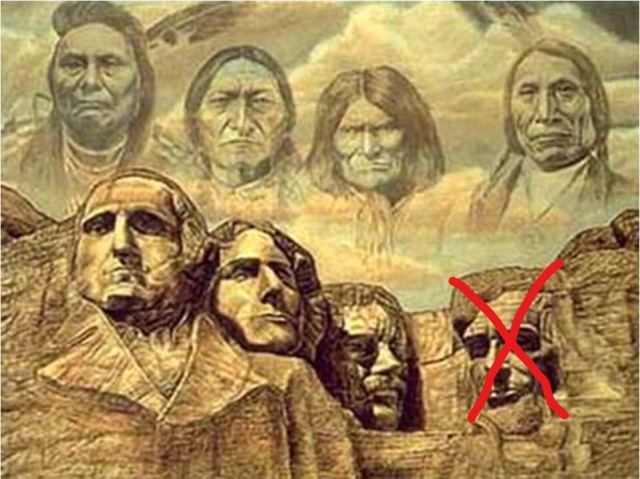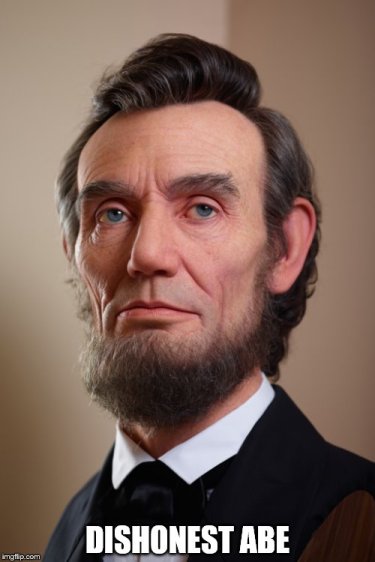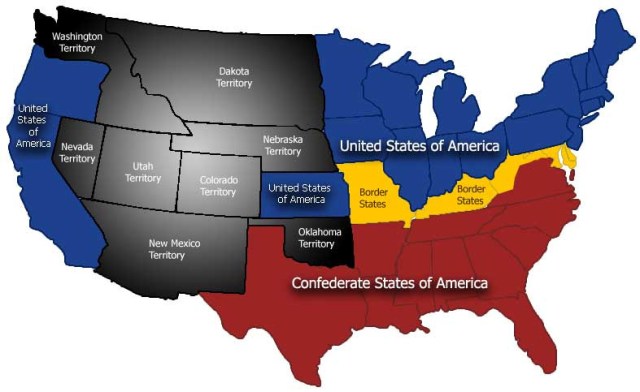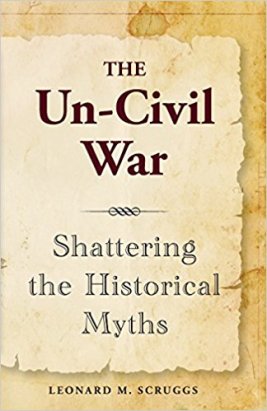
(Excerpted from Mike Scruggs’ book, THE UN-CIVIL WAR; Chapter 8: “The Cherokee Declaration of Independence”)
Most Americans have been propagandized rather than educated on the causes of the War Between the States (aka, The War of Northern Aggression; aka, The War to Prevent Southern Independence; aka, the Civil War) in order to exonerate the perpetrators and victors and justify their actions. But the truth is out there for anyone willing to take the time to do some reading.
The true perspective comes from the South, for it was the Confederate states who were the ones standing up and fighting for principle. If the truths and ideals articulated in the Declaration of Independence were still going to mean anything, the Confederacy would have to fight for them. In Chapter 8 of his book, THE UN-CIVIL WAR, Mike Scruggs discusses the views of the Cherokees with respect to the splitting of the country in 1860-61 uses those views to support the truth of the war.
In 1861, there were two principal groups of Cherokees in the United States – the Western Band, with a population of slightly over 20,000, and the smaller Eastern Band, located in North Carolina, with a population of only about 2000. Both sided with the Confederacy, but the larger Western Band made a formal Declaration of Independence from the United States.
On August 21, 1861, the Western Cherokee Nation, by a General Convention in Tahlequah (Oklahoma), declared its common cause with the Confederate States against the Northern Union. A treaty was concluded on October 7 between the Confederate States and the Cherokee Nation and on October 9, John Ross, the Principal Chief of the Cherokee Nation called into session the Cherokee National Committee and National Council to approve and implement that treaty and a future course of action.
The Cherokee had much more in common with their Confederate neighbors than with the North, but their treaties had been with the government of the United States (now the Northern Union). At first they thought best to honor those treaties. But with the invasion of its neighbors, the repression of free speech and press by Lincoln, the complete trampling of the US Constitution, and the support the North had given to individuals and groups leading up to the war (such as John Brown) who urged violence against the South, the Cherokee soon changed their mind.
The Cherokee were perhaps the best educated and literate of the American Indian tribes. They were also among the most Christian. Learning and wisdom were highly esteemed. They revered the Declaration of Independence and the US Constitution as particularly important guarantees of their rights and freedoms, just as Southerners did. It is not surprising therefore that on October 28, 1861, the National Council of the Western Cherokee Nation issued its own Declaration of Independence – Declaration of the People of the Cherokee Nation of the Causes Which Have Compelled Them to Unite Their Fortunes With Those of the Confederate States of America.
The introductory words of this Declaration strongly resembled the 1776 Declaration of Independence:
“When circumstances beyond their control compel one person to sever the ties which have long existed between them and another state or confederacy, and to contract new alliances and establish new relations for the security of their rights and liberties, it is fit that they should publicly declare the reasons by which their action is justified.”
In the next paragraph, the Council noted the Cherokee Nation’s faithful adherence to treaties with the United States its attempts at neutrality in the face of the hostilities between the North and the South. But the seventh paragraph began to articulate their alarm at the North’s aggression and their sympathy with the South: “But Providence rules the destinies of nations, and events, by inexorable necessity, overrule human resolutions.”
Comparing the relatively limited objectives and defensive nature of the Southern cause to the aggressive actions of the North, the Declaration included this observation:
“Disclaiming any intention to invade the Northern States, they (the Southern States) sought only to repel the invaders from their own soil and to secure the right to govern themselves. They claimed only the privilege asserted in the Declaration of American Independence, and on which the right of the Northern States themselves to self-government is formed, and altering their form of government when it became no longer tolerable and establishing new forms for the security of their liberties.”
The next paragraph noted the orderly and democratic process by which each of the Confederate States seceded. This was without violence or coercion and nowhere were liberties abridged or civilian courts and authorities made subordinate to the military. The following (ninth) paragraph contrasted this with the ruthless and totalitarian trends in the North:
“But in the Northern States, the Cherokee people saw with alarm a violated Constitution, all civil liberty put in peril and all rules of civilized warfare and the dictates of common humanity and decency unhesitatingly disregarded. In the states which still adhered to the Union, a military despotism had displaced civilian power and the laws became silent with arms. Free speech and almost free thought became a crime. The right of habeas corpus, guaranteed by the Constitution, disappeared at the nod of the Secretary of State or even a general of the lowest grade. The mandate of the Chief Justice of the Supreme Court was at naught (negated) by the military power and this outrage on common rights was approved by a President sworn to support the Constitution. War on the largest scale was waged and immense bodies of troops called onto the field in the absence of any warranting it, all under the pretense of suppressing a rebellion.”
The tenth paragraph continued the indictment of the Northern political party in power (the Republican Party) and the conduct of the Union Armies:
“The humanities of war, which even barbarians respect, were no longer thought worthy to be observed. Foreign mercenaries and the scum of the cities and the inmates of prisons were enlisted and organized into brigades and sent into Southern States to aid in subjugating a people struggling for freedom, to burn, to plunder, and to commit the basest of outrages on the women. While the heels of armed tyranny trod upon the necks of Maryland and Missouri, men of the highest character and position were incarcerated upon suspicion without process of law, in jails, forts, and prison ships, and even women were imprisoned by the arbitrary orders of a President and Cabinet Ministers. The press ceased to be free and the publication of newspapers was suspended and their issues seized and destroyed. The officers and men taken as prisoners in the battles were allowed to remain in captivity by the refusal of the Government to consent to an exchange of prisoners. They left their dead on more than one field of battle that had witnessed their defeat, to be buried and to have their wounded to be cared for by Southern hands.”
The eleventh paragraph of the Cherokee Declaration is a fairly concise summary of their grievances against the political powers then presiding over a new US Government:
“Whatever causes the Cherokee people may have had in the past to complain of some of the Southern States, they cannot but feel that their interests and destiny are inseparably connected to those of the South. The war now waging is a war of Northern cupidity and fanaticism against the institution of African servitude, against the commercial freedom of the South, and against the political freedom of the States, and its objects are to annihilate the sovereignty of those states and utterly change the nature of the general government.”
Finally, appealing to their inalienable right to self-defense and self-determination as a free people, the Cherokee concluded their Declaration with the following words:
“Obeying the dictates of prudence and providing for the general safety and welfare, confident in the rectitude of their intentions, and true to their obligations to duty and honor, they accept the issue thus forced upon then, unite their fortunes now and forever with the Confederate States, and take up arms for the common cause, and having complete confidence in the justice of that cause, and with a firm reliance upon Divine Providence, will resolutely abide the consequences.”
The Eastern Band of Cherokee made no such formal declaration, but considered themselves North Carolinians and were anxious to join Confederate forces in defending their state and the Southern cause. The Eastern Band Chief, Col. William H. Thomas, a North Carolina State Senator, gathered 416 Cherokee braves to form the core of what later became the Thomas Legion. They were joined by about 1,900 North Carolina mountain men. Thomas, of Welsh descent, was the adopted white son of the late Eastern Band Chief, Yanaguska (“Drowning Bear”). He is said to have spoken the Cherokee language better than any white man that ever lived. The Cherokees had come to have great respect for his wisdom and relentless hard work on their behalf in North Carolina. It should be noted that the Cherokee braves that served in the Thomas Legion represented almost every single male of military age in their small population. They served very faithfully with only about a dozen known to have deserted.
Both Cherokee bands proved their courage and loyalty. The last shot fired in the war east of the Mississippi was fired on May 6, 1865. This was in an engagement at White Sulfur Springs, near Waynesville, NC, in which part of Thomas’ Legion fought against Union Army Colonel George W. Kirk’s infamous Union Raiders. Kirk’s Raiders had engaged in a campaign of murderous terrorism and destruction on the civilian population of western North Carolina. It took some effort at the end of the war for Thomas to persuade his Cherokee braves to surrender rather than continue guerrilla warfare against the Union.
In the West, Confederate Brigadier General and Cherokee Chief, Stand Watie’s mounted infantry regiments became a legend for their guerilla cavalry tactics, baffling and diverting a great number of Union troops. On June 23, 1865, in what was the last land battle of the war, Brigadier General Watie finally surrendered his predominantly Cherokee (Oklahoma) Indian force to the Union.
The issues as the Cherokees saw them were many-fold:
(1) The Right of Self-Defense, against Northern aggression, both for themselves and their fellow Confederate neighbors and friends
(2) The Right of Self-Determination by a free people, recognized in the Declaration of Independence
(3) Protection of their Government of Law (their Rule of Law)
(4) Preservation of their political rights under a constitutional government
(5) A strong desire to retain the principles of limited government and decentralized power guaranteed by the Constitution
(6) Protection of their economic rights and their welfare
(7) Dismay at the despotism of the party (Republican Party) and leaders in command of the US government
(8) Dismay at the ruthless disregard of commonly-accepted rules of warfare by the Union, especially their treatment of civilians and non-combatants
(9) A fear of economic exploitation by corrupt politicians and their supporters based on observed past experience (harsh protective tariffs)
(10) Alarm at the self-righteous and extreme, punitive, and vengeful pronouncements on the slavery issue voiced by the radical abolitionists and supported by many Northern politicians, journalists, and social and religious leaders
The Cherokee Declaration of Independence of October 1861 uncovers a far more complex set of “Civil War” issues than most Americans have been taught. Rediscovered truth is not always welcome. Indeed, some of the issues addressed by the Cherokee Nation are so distressing that the general academic, media, and public reaction is to rebury them or to (intellectually) shout them down as politically incorrect.
The notion that slavery was the only real or even principal cause of the war is very politically correct and widely-held, but not historically correct. It amounts to historical ignorance. The version of the war taught to our children in the public schools and even in our universities – that slavery was the cause of the Civil War – has served, however, as a convenient ex-post facto justification for the North’s decision to instigate war on the Confederate States and its brutal conduct in prosecuting its war. Slavery was an issue, of course, but it was by no means the only issue, or even the most important underlying issue. It was not even an issue in the way most people think of it. Only about 25% of Southern households owned slaves. For most people, North and South, the slavery issue was not one that touched them in their personal or economic lives. The slavery issue was not so much whether to keep it or not, but how to phase it out without causing economic and social disruption and disaster. Unfortunately, since slavery was an institution in the Southern States and since it was protected in the US Constitution, those states believed that the decisions as to how to phase it out and to deal with the resulting economic and social issues should have been left to them – not to radical abolitionists or to the federal government.
After the (unconstitutional) Reconstruction Acts were passed in 1867, the radical abolitionists and radical Republicans, both equally evil-intentioned, were able to issue in a shameful era of politically-punitive and economic exploitative oppression in the South, the results of which lasted many years, including the birth of the Jim Crow/segregationist era. The sins that the country often associate with the South are often, in reality, the policies and actions of the North.
The Cherokee were – and are – a remarkable people who have impacted the American heritage far beyond their numbers. As this commentary shows, they were remarkably patriotic as well. We can be especially grateful that they made a well-thought out and articulate Declaration of Independence in support of the Confederate cause in 1861 and in joining their defense.
To Purchase Lawrence (“Mike”) Scruggs’ book, THE UN-CIVIL WAR: Amazon – https://www.amazon.com/Civil-War-Shattering-Historical-Myths/dp/098343560X/ref=sr_1_fkmr0_1?ie=UTF8&qid=1517505890&sr=8-1-fkmr0&keywords=Lawrence+Scruggs%2C+The+Un-Civil+War




